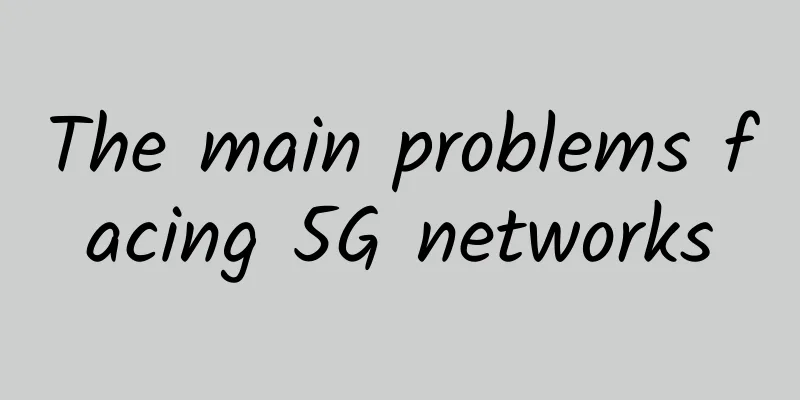The main problems facing 5G networks

|
5G networks are the next generation of wireless technology. They are expected to provide faster speeds, lower latency and higher data capacity than previous generations. 5G networks will be key to driving the next wave of technological innovation, including self-driving cars, Internet of Things devices and virtual and augmented reality applications. These networks enable users to download movies in seconds or live stream video with no lag/buffering, allow surgeons to perform surgery remotely, and reverse climate change through smart energy and pollution management systems. 5G networks are also expected to have a significant impact on economic growth: a Nokia study estimated that 5G networks could add $8 trillion in value to the global economy by 2030. However, 5G networks are not without their issues. Here are some of the major issues and trends affecting 5G networks and how enterprises can respond to this rapidly evolving market. What is 5G network?5G is the next generation of wireless connectivity technology that promises to revolutionize how users experience the connected world. 5G networks are faster and more reliable than previous generations, with download speeds ranging from 1 to 10 gigabits per second. This enhanced speed and reliability will enable a new wave of innovative technologies, from virtual reality experiences to robotics to artificial intelligence. 5G will also be more efficient than previous generations, significantly reducing latency (the time it takes for a device to send and receive data) to as little as 1 millisecond. This will enable new applications that were previously impossible, such as real-time augmented reality and remote surgery. In short, 5G is more than just a new generation of wireless connectivity - it is a transformative technology that will change the way people live, work and play. From a technical perspective, 5G networks are based on a new, more efficient coding scheme called OFDM (Orthogonal Frequency Division Multiplexing). OFDM is a digital modulation method in which data is transmitted using a large number of closely spaced carrier frequencies. This approach offers several advantages over older coding schemes, including improved spectral efficiency, reduced multipath distortion, and improved immunity to interference. 5G networks also use advanced antenna arrays and beamforming technology to focus wireless signals directly on users' devices, rather than broadcasting them indiscriminately in all directions. This will further improve spectral efficiency and reduce interference levels. By leveraging these next-generation technologies, 5G networks will be able to deliver unprecedented levels of performance and reliability. 5G Network TrendsRapid adoption According to GSMA, 5G will account for 8% of global mobile connections in 2021, and this number is expected to grow to at least 2 billion 5G connections by 2025. This rapid adoption trend is driven by people wanting to take advantage of 5G, the increasing availability of 5G devices, the falling prices of 5G services, and the launch of 5G networks in more countries around the world. ●Bandwidth competition As 5G technology continues to be developed and deployed, the resulting competition for bandwidth is the result of large telecom companies competing for market position. Recently, the Federal Communications Commission (FCC) auctioned radio frequency bands to 5G enterprise telecom companies. The auction triggered an RF gold rush with a total transaction volume of $81 billion. This competitive landscape is likely to continue as providers look for ways to differentiate their services and attract enterprise customers. Edge computing improvements Edge computing technology enables businesses to compute data closer to the source of the data, rather than sending it back to the cloud for processing. By doing so, businesses can enjoy faster speeds and better latency. Additionally, edge computing can help improve security and privacy since data never needs to leave the premises. As a result, more and more businesses are looking to adopt edge computing and take advantage of its many benefits. 5G will play an important role in achieving this goal as it has the bandwidth and low latency required to support edge computing. Therefore, it can be expected that the enterprise 5G market will significantly increase the adoption of edge computing in the next few years. ● Growth in the router and switch market Since the accessible performance potential is huge, enterprises will want to ensure that their routers and switches can keep up. Many enterprises are adopting new 400Gbps routing technologies. This trend is expected to contribute significantly to the overall market growth. ●Business support 5G networks are becoming increasingly popular with businesses because they are much faster than 4G, meaning businesses can take advantage of the higher speeds for data-intensive tasks such as video streaming and large file transfers. In addition, 5G has much lower latency than 4G, which means there is less delay between when a user initiates an action and when it is executed. This is especially important for applications that require real-time responses, such as video conferencing and online gaming. Five major issues facing 5G networksDue to several issues currently affecting 5G networks and acting as barriers to adoption, it may be some time before the full benefits of 5G are realized. Ecosystem availabilityGlobally, there is limited availability of critical infrastructure outside of urban centers. This lack of infrastructure makes it difficult to deploy 5G networks in rural areas. In addition, the high cost of 5G equipment is another barrier to deployment. Although some telecom companies are investing in 5G infrastructure, the investment required is huge and widespread adoption of 5G networks will take time. In the meantime, several solutions have been proposed to address the problem. One solution is to use higher-frequency spectrum, which is more abundant in rural areas. Another solution is to use base stations that are smaller and easier to deploy than traditional base stations. Education and understanding5G is more than just an evolution of existing 4G technology – it’s an entirely new network that requires different approaches to deployment, management and security. Unfortunately, not all key business decision makers fully understand 5G and the business-enabling benefits it brings. Therefore, companies need to invest in educational resources to fully leverage the potential of 5G and help understand the technology and its impact. Only in this way can they make informed decisions and ensure a successful 5G rollout. consciousness5G is still in its infancy and there is a lot of confusion in the boardroom about what it is and how it will be used. According to Nokia, more than one in five technology buyers believe that implementing 5G is not a priority for their current business. This lack of awareness could delay the rollout of 5G networks and prevent businesses from realizing the full potential of this groundbreaking technology. To overcome this challenge, companies are working to educate business leaders about the benefits of 5G and the ways it can be used to improve efficiency and drive growth. Cost and complexityAs operators strive to meet data demand and support new applications, the deployment of 5G networks is becoming increasingly complex and expensive. One of the key issues facing 5G networks is the need for base station density, which requires a large investment in infrastructure. In addition, 5G networks face the challenge of supporting a variety of new applications, such as augmented reality and virtual reality. These applications place new demands on the network, causing congestion and latency. As a result, operators are under pressure to increase network capacity and ensure a high-quality user experience. SafetyAs 5G networks become more popular, security issues are becoming more prominent. With the increase of IoT devices connected to the network, 5G networks have a larger attack surface than previous generations of cellular networks. In addition, 5G networks are more complex, making it more challenging to identify and fix security vulnerabilities. Supply chain and software vulnerabilities are also a problem because it is often difficult to know where components come from and whether they have been tampered with. Despite these challenges, there are steps that businesses can take to reduce the risks associated with 5G networks. By working with trusted vendors and partners, conducting regular security audits, and implementing strict security policies, businesses can help ensure the security of their 5G networks. Future issues with 5G networks5G promises faster speeds, lower latency, and greater capacity than its predecessors. The new generation of network technology will usher in a wave of technological innovation, including the development of the Internet of Things, driverless cars, and virtual reality. While 5G adoption is still in its early stages, several trends are emerging that will shape the future of this technology. Accessibility 5G adoption will become more accessible. Currently, 5G is only available in select areas and is generally quite expensive. However, as infrastructure is built out and more service providers enter the market, prices are expected to drop, making 5G more accessible to consumers and businesses. Industry 4.0 With 5G, new capabilities will ultimately catalyze the next industrial revolution. 5G is often referred to as the foundation of Industry 4.0, the fourth industrial revolution driven by digital technology. With its high speed and low latency, 5G will enable new applications and use cases that were not possible with previous generations of cellular networks. This will bring new business opportunities to all industries and pave the way for the next wave of economic growth. Virtual reality and augmented reality 5G will continue to enable mixed reality services. Augmented reality and virtual reality are already being used in many industries, such as gaming, education, and retail. With 5G, these services will become even more realistic and immersive as latency decreases and image quality improves. This development will have a significant impact on the way people interact with technology and could lead to widespread adoption of mixed reality services in people’s personal and professional lives. ●Open operation One trend that could shape the future of 5G is OpenRAN (Radio Access Network). OpenRAN refers to the move away from proprietary network equipment to equipment based on open standards that can be sourced from multiple suppliers. This will increase competition in the market and provide support for more diverse radio technologies. OpenRAN has been adopted by many operators around the world and is seen as a key enabler for the deployment of 5G in many countries. 5G in the next few years5G represents a major shift in the way people connect to the world around them. The technology is still in its early stages, but it has the potential to revolutionize the way people live, work, and play. The trends outlined above will shape the future development of 5G networks and help determine how this transformative technology will be used in the coming years. |
<<: Understanding Overlay Network Technology
>>: Cisco Releases Fourth Quarter and Full Year Results for Fiscal 2022
Recommend
Point2 launches 5G RangeXtender to increase network fronthaul and backhaul range
Point2 Technology said its 5G RangeXtender allows...
Good news for 5G: the rate is no higher than 4G, and you don’t need to change your phone number when you change your phone
Large bandwidth, large connections, low latency a...
China Mobile Zhejiang and Wind River successfully complete NovoNet Phase I testing
China Mobile Zhejiang Company recently completed ...
The EU will accelerate the layout of 5G big data. Industry organizations say it is urgent to narrow the gap with China, the United States and other countries
The European Commission issued an initiative on S...
What does the request data packet go through from sending to receiving?
Previously, we talked about how the domain name i...
XDP technology for high-performance network framework
1. Basic Concepts of XDP XDP stands for eXpress D...
200M broadband speed still can't be increased. It turns out that these points are not done correctly.
As early as last year's World Telecommunicati...
A detailed explanation of the HTTP protocol
[[393100]] 1. Introduction to HTTP Protocol HTTP ...
China has 1.011 billion Internet users. After 27 years of Internet development, it has become a place for wealth creation.
27 years ago, anyone who mentioned the word "...
How is LOCVPS? Simple test of LOCVPS Hong Kong Tai Po VPS
Last month, we conducted a simple test on LOCVPS ...
RAKsmart: Bare Metal Cloud in the US/Hong Kong/Japan $49/month - E5-2620, 32G RAM, 1TB HDD, 50-100M Bandwidth
RAKsmart is a hosting company founded by overseas...
Accident review: We duplicated the order ID!
[[428490]] introduce In many business systems, we...
2G is shut down in many places. How can NB-IoT and Cat.1 seize the opportunity in the reshuffle?
It's the start of the new school year again, ...
5G is coming, do I need to change my SIM card?
2019 is the first year of 5G. With the issuance o...





![[Black Friday] Megalayer: Hong Kong/Singapore VPS flash sale 9.9 yuan/month, Hong Kong server 199 yuan/month, top up and get 10% back](/upload/images/67cabcfaacf10.webp)



